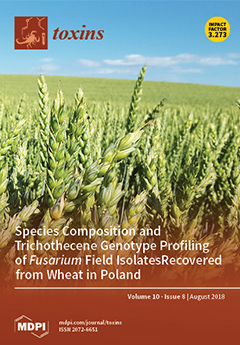As contamination with cereal ergot has been increasing in western Canada, this study evaluated impacts of feeding a mycotoxin binder (Biomin
® II; BB) on nutrient digestibility, alkaloid recovery in feces, and lamb growth performance. Forty-eight ram lambs (25.9 ± 1.4 kg) were
[...] Read more.
As contamination with cereal ergot has been increasing in western Canada, this study evaluated impacts of feeding a mycotoxin binder (Biomin
® II; BB) on nutrient digestibility, alkaloid recovery in feces, and lamb growth performance. Forty-eight ram lambs (25.9 ± 1.4 kg) were randomly assigned to one of four barley-based diets: Control (C), no added alkaloids, Control + BB fed at 30 g/head per day (CBB); Ergot, 2564 ppb total
R +
S epimers (E); Ergot + BB, 2534 ppb
R + S epimers (EBB). Lambs were fed ab libitum for up to 11 weeks until slaughter at >46 kg live weight. Both average daily gain (ADG) and gain/feed ratio were greater (
p < 0.01) for lambs fed C and CBB diets as compared with those containing added ergot, although dry matter intake was not affected by dietary ergot or BB. Serum prolactin concentrations were two times higher in EBB- compared with E-fed lambs (
p < 0.05), although both were lower than in C or CBB (
p < 0.001) lambs. Rectal temperatures were greater in lambs receiving dietary ergot (
p ≤ 0.001) than in C- and CBB-fed lambs. In a digestibility study using eight ram lambs, treatment with BB increased neutral detergent fiber (NDF) digestibility (
p = 0.01). Nitrogen retention (g) was greater (
p < 0.05) for lambs receiving C or CBB compared with ergot-contaminated diets. Feces of EBB lambs had 38.5% greater (
p < 0.001) recovery of alkaloids compared with those fed E. Based on sparing of prolactin, BB may reduce impacts of ergot alkaloids by increasing their excretion in feces. Accordingly, concentrations of dietary alkaloids, which would not harm sheep, would be increased by feeding BB.
Full article






